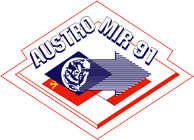In space, vehicles charge up with existing electrically charged particles and radiation fields as opposed to environment plasma. This occurs in particular due to the shortwave sunlight hitting the space vehicle’s surface, creating a photo-effect which in turn effects an emission of photo-electrons and therefore, under certain conditions, charge the space vehicle positively. On the one hand, this charge-up affects the execution of scientific experiments on the spaceship (e.g. falsification of measurements from low-engery ion and electron densities in space plasma), and on the other hand differential charging of various particles of the outer shell can lead to electrical overcharging, device failure and also affect the power supply (solar cells).
Objectives
The positive static charging of a space vehicle as opposed to space plasma can be compensated with the emission of particles with a positive electric charge (ions). For this reason one brings an ion transmitter on board. It emits a ray of energetic ions in space, whose strength is about the same as the emitted photo-electron stream. Liquid metal field ion emitters are small, light, durable and require less energy. Such emitters were chosen as the potential regulator for space vehicles (amongst the ASPOC instrument on the European research satellite CLUSTER, the SPEX instrument on the Russian satellite INTERBALL).
The flight of an Austrian cosmonaut to the soviet MIR space station provided the first opportunity to test a liquid metal emitter in microgravity. This enabled the optimization of flight hardware and software before the first deployment for potential regulation reasons.
Functionality, Measuring principle
A liquid metal ion source (LMIS) contains a metal needle with a tip curvature radius of a few micrometers. It is dipped into a reserve tank with liquid metal. The metal is melted through electric heating – indium is used due to its low melting point – and covers the needle’s free surface. If a high positive electric charge, as opposed to a terrestrial extraction electrode, is placed on the needle, positive metal ions are emitted. This is due to the local extreme high electrical field strength through field evaporization, directing them to the extraction electrode by accelerating them to high energies and thus forming into a ray. Atoms are lost by the emission of the ray from the liquid metal surface and these are compensated with the slipstreams from the liquid metal reservoir so that a stable ion ray is discharged from the emitter.
As no Austrian device for the AUSTROMIR cargo was planned for deployment outside the space station, the environment condition „free space“ had to be built in the device. The required high-vacuum was sustained by the device’s own ion pump. The pump was immediately activated as the deivces were brought on board the space station on 23 August 1991. A module with 3 liquid metal ion emitters was built into a hermetically closed vacuum system. The emitters were individually started and the emitted ion ray collected by means of an internal collector. The cosmonaut controlled the experiment with the help of the central computer DATAMIR, whereby all relevant data was registered and saved on magnet cards and diskettes, and brought back to earth after the flight.
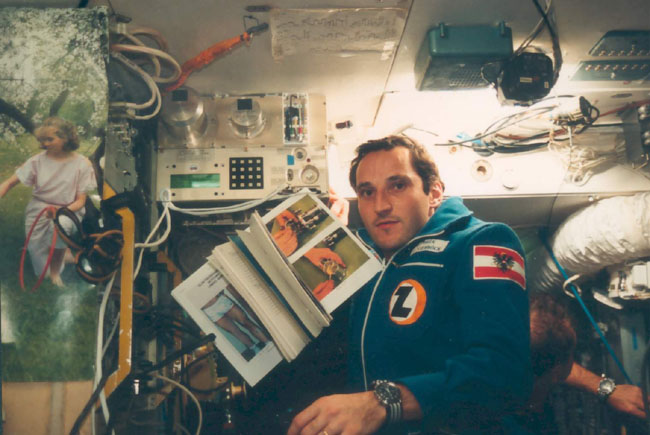
The data from the emitter module in microgravity was compared with a similar module activated on the ground. The emitters were unmounted and brought back to earth so that the wetting of the emitter tips and the distribution of the liquid metal in the reservois could be studied using electron-microscopic and micro-analytical methods.
Shared equipments of the Austrian payload
DATAMIR
Results
The experiment has for the first time shown that a liquid metal field ion emitter with a long running reservoir is suitable for a long application time in microgravity. The system parameters of the emitter are similar to the ones measured on the ground. The measured average stability of the indium-ion stream emitted from the module was about 4%. This enables this emitter type to be deployed for the potential control of space vehicles.
The emitter module that was brought back to earth was examined with the help of secondary ion mass spectrometry. This has shown that a multi-emitter module limits the stability of the parameters from the electrodes to the cold tips. In single-emitter modules, as deployed in the MIGMAS-A experiment, these contamination effects are considerably less due to the self-cleaning process of the running emitter.
Practical application
Application ranges
- Check of the operating conditions of space matters (e.g. missions GEOTAIL, CLUSTER, INTERBALL)
Application target
- Increase of the safety of manned and unmanned space missiles
- Check of the electrostatic potentials of space devices on the basis of a liquid metal ion emitter
- Automatic control of a liquid metal ion emitter
Direct interested institutions on the utilization of the experiment results
- Austrian Research Center Seibersdorf Ges.m.b.H., Seibersdorf
- Max-Planck-Institute for Atom Physics, Heidelberg, Germany
- Company of Hoerner & Sulger, Schwetzingen, Germany
- Institute for Communications Engineering and Wave Propagation of the Technical University Graz
- Institute for Space Research of the Austrian Academy of Sciences, Graz
- ISAS, Tokyo, Japan
Technical characteristics
The equipment LOGION consisted of the following units
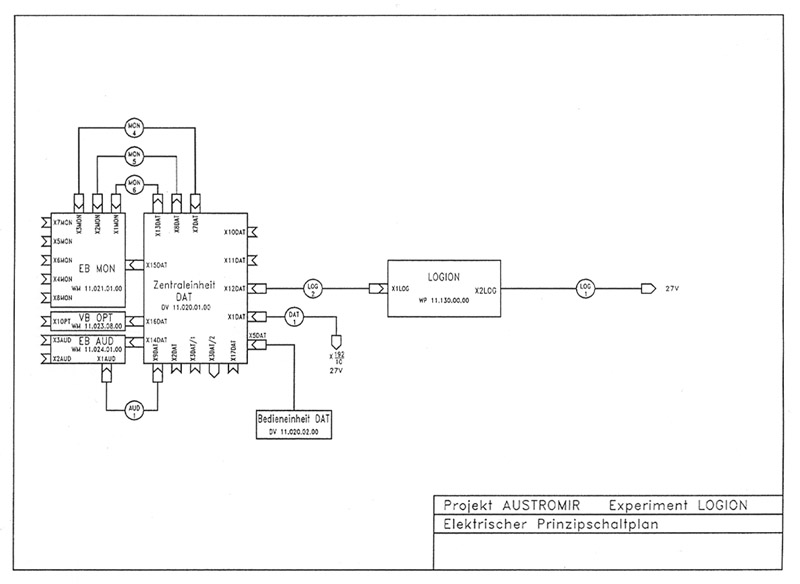
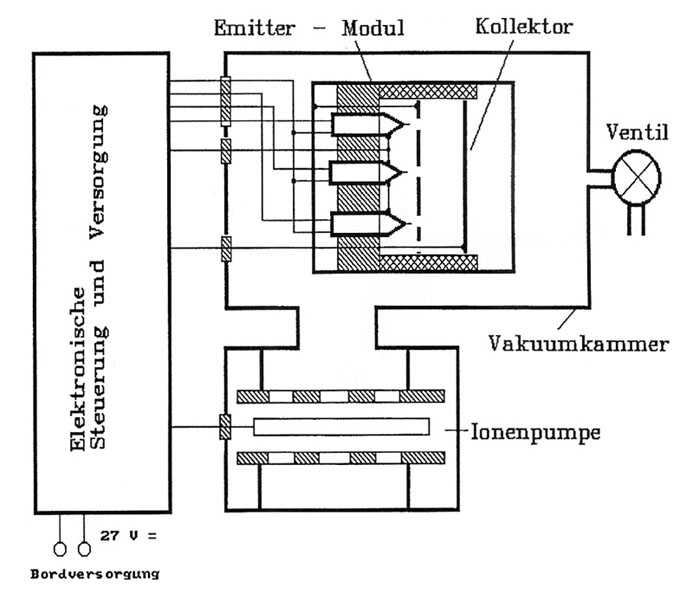
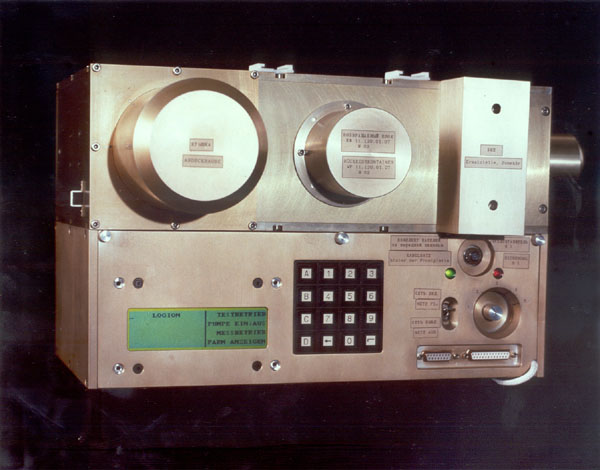
Photo 2 (top right): Block diagram of the equipment LOGION
Photo 3 (bottom): The equipment LOGION
Photo an Charts: BMBWK, Vienna
Elektronic box with cables
- Emitter modul with 3 ionic emitters
- Vacuum chamber
- Ion getter pump for upkeeping the Vacuum
- Power supply unit
- Processing and data recording
- Set of cables
- Return transport box for the emitter modul
- Tool box with wrench (4 pieces) and gripper
- Protective cover for the LCD-display
| Mass: | 14.8 kg |
| Dimensions: | 465 mm x 350 mm x 262 mm |
| Power input: | 28 W |
Experimenters
Part I:
Univ.-Prof. Dr. Friedrich Ruedenauer
Dipl.-Ing. Dr. Michael Fehringer
Dr. Walter Steiger
Dipl.-Ing. M. Kammerhofer
all: Austrian Research Center Seibersdorf Ges.m.b.H., Seibersdorf
Part II:
o. Univ.-Prof. Dipl.-Ing. DDr. Willibald Riedler (project officer)
Dipl.-Ing. Dr. Klaus Torkar (project manager)
Dipl.-Ing. Ernst Goeschl
Dipl.-Ing. Christian Kropiunig
Sonja Neukirchner
all: Institute for Space Research of the Austrian Academy of Sciences, Graz
